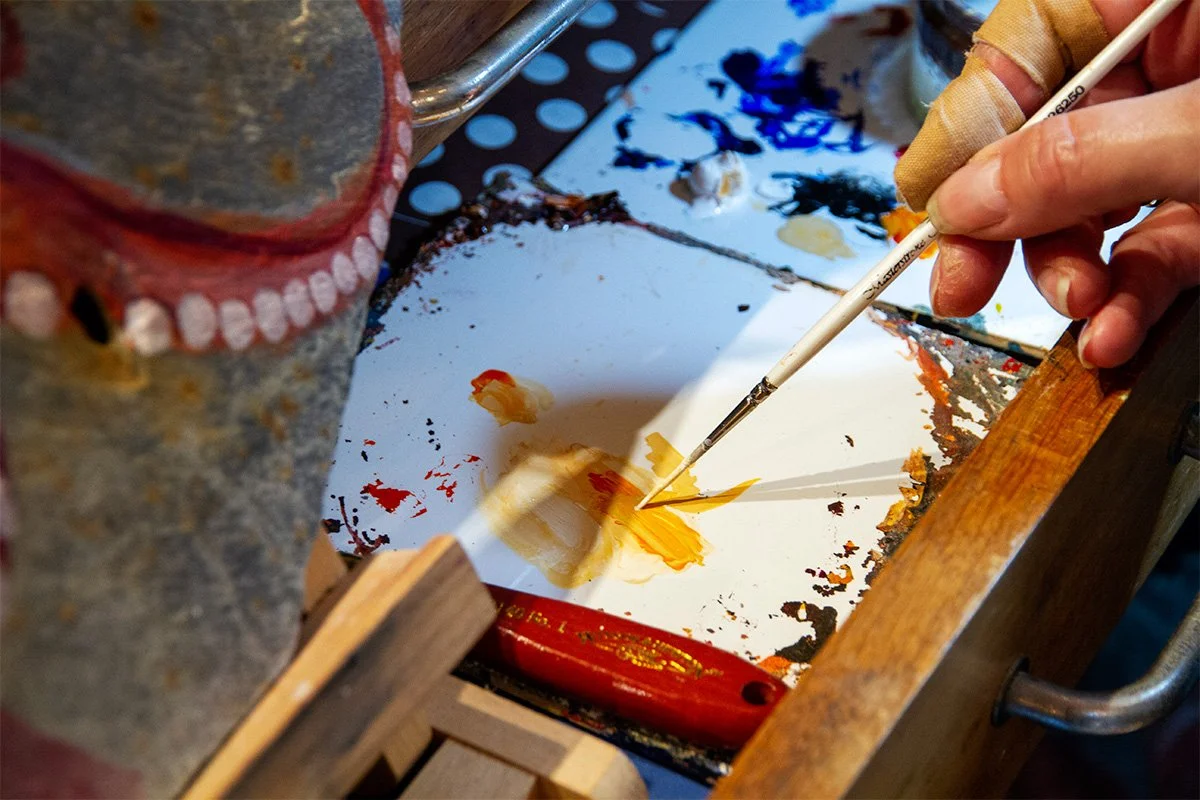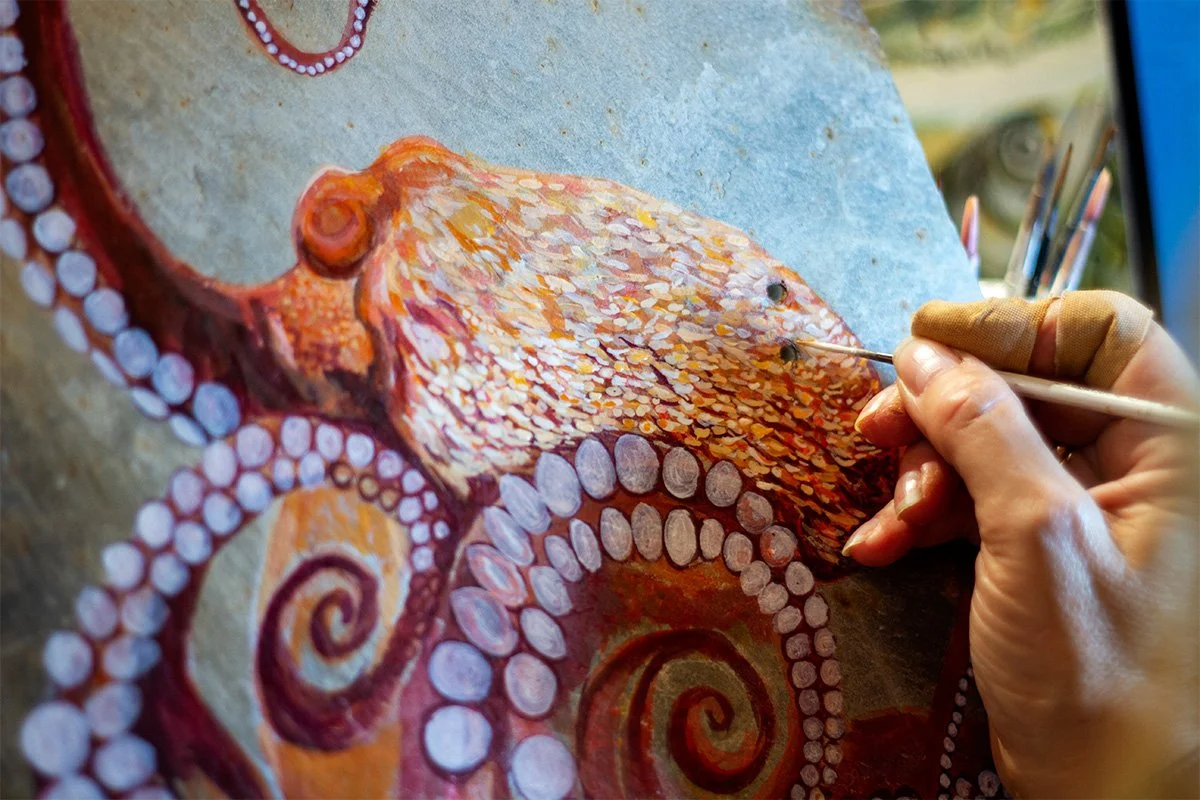Port Isaac People: Artist Lyndsey Bradbury
“I love detail and the shapes and the colors of all of the incredible fauna and flora that lives along this coast, and I like the challenge of painting a lobster!”
The Pentus Wall Studios that sit above the beach at Port Isaac are old fishermen’s stores that are now home to a pair of artist’s studios. One of these studios is the workplace and gallery of artist Lyndsey Bradbury, who paints native Cornish sealife and sea birds using reclaimed local slates as her canvas.
As the summer sunshine extended into autumn and the village started to quieten down ever so slightly, we took the opportunity to catch up with Lyndsey to learn more about her art.
Can you tell us about how you came to be practicing your art in Port Isaac?
Well, I’ve lived in or around Port Isaac for the last ten years or so. I’ve always been making art, one way or another; I used to work as an art teacher at a secondary school in Hampshire before moving to Cornwall, and the two defining elements of my adult life really have been creating art and living close to the sea.
How did you come to develop your distinctive medium and style?
There was an RNLI charity craft fair one Christmas to raise money for the lifeboats, and I made a series of fish paintings and a few sea birds on some pieces of slate that I had. I’d always worked in this way, going back years to when I did my art degree when I used to do a lot of work based on shells and sort of cornucopia, based on wood carvings and things like that. I did a textile design degree but I was mainly painting and pulling in elements of the natural world. I’m not an abstract artist, I’ve always worked in a very detailed and realistic way.
How do you create these slate pieces?
I paint with acrylics onto the slate and just build up and build up, more and more layers, adding more and more detail using increasingly finer brushes, and then I varnish over the top of the paint with an acrylic varnish which helps to make the colours pop and create more of a contrast with the grey of the slate.
Do you source the slates from Port Isaac?
Almost all of them, yes. They’re roof or wall-cladding slates. Some have come off the roof of these cellars when they’ve come down in storms and the roof has been repaired. Some came from a building behind the Methodist Chapel that Barbara [Hawkins, another local artist] gave to me. She had a lean-to shed that fell down in a storm and they wanted to clear it so I’ve repurposed those slates. Local builders give me slates from renovations or roof repairs that they’re doing. Almost all of them are slates from the Delabole quarry. Then there are some slates from St Neot, from a Methodist Chapel there, which are a lot blacker than the Delabole slate. It’s always Cornish slate, though.
They’re all marked and misshapen, and I actually really like that. Obviously most of them are or have started as a rectangle, but I love the uneven edges and the holes where the nails went with the rust marks around them. It’s all part of its story. The more irregular shape that the slate the better for me! That sort of stems from when I used to start a drawing in the middle and just creep out and then I would stick bits of paper on it if I needed more space. I always struggle to know when to finish things so by having an uneven edge and working to that shape It gives me something to work within. I really like the idea with pieces going off the slate that you know it would have extended off that way and you have to imagine the rest of it.
You’ve got a great view of the harbour, Roscarrock Hill, and Lobber out of your studio door, but you’re not painting landscapes of Port Isaac. What made you go down the route of botanical illustrations?
It is a beautiful and iconic view, and it does find its way into my work occasionally, but I’m drawn to painting the sealife and seaweeds and seabirds because I love the organic shapes and the really fine details in all of them. I think that I struggle to paint things that have got a man-made element to them! And some of my subject matter, like the jellyfish, are so fine and detailed, and such a great challenge to recreate because they’re effectively transparent, and I just wouldn’t get that painting the view out of the door.
Do you have a favourite subject to paint?
I like to paint the John Dory in particular. I know that they aren’t the most attractive fish, but there’s something translucent about them and they’re almost like a fossil. I quite like fossils and that sort of thing. And I like painting the different jellyfish, too. Anything that is a bit of a challenge, where I have to almost create something out of nothing. There’s so much translucence and there's so much texture in a jellyfish, and you can't go in too heavy with it. It's probably the one situation when you have to show some control, whereas when I'm painting the mackerel or the mussels and things like that, because they are a solid entity and I have painted them so often I don’t have to think about it so much. So I enjoy the subjects that challenge me a bit.
Can you tell us a bit about the textile pieces that you have in here? They’re quite different to the slates!
My degree had a textiles focus, so it’s a medium that I have a real love for. I’ll take my sketchbooks out with me, and sketch and take photographs, and then I’ll develop an idea of what I want to create. I start with a piece of fabric on my embroidery machine and my idea, and then because the fabric has quite an open weave it gets moulded about as the stitches go in and pull it around. I layer up the embroidery and the piece shrinks and contracts and takes on a direction of its own, so it’s a very dynamic way of working and creating.
Can you tell us how you came to have your studio here, in the Pentus Wall overlooking the beach?
I bought it at auction to use as a sort of shed, originally! I live in a flat in a house on the other side of the road that these studios back onto [Fore Street] but it’s small and there’s very little storage space. So when this space came up for auction as part of somebody’s estate I thought I’d get it to put a freezer in, and to store my kayak close to the beach.
After I bought it I opened the door and I thought, “Oh my God, what've I done!” It had a mezzanine level in it but it was very low and it was just full of fishermen's stuff. It had been a fisherman's store before, and had been since it was built. Going back to when there was a pilchard industry in Port Isaac they’d store barrels of pilchards in here before they were shipped off, and after that it became a net loft and general store for all of their equipment. But then once I’d got electric in here I realised what an ideal opportunity it was to turn it into an artist’s studio. There’s a kind of mezzanine platform, so there’s still lots of storage under there, lots of it filled with old slates, as well as the space functioning as a studio and small gallery.
It’s an incredible location. How does the space change through the year, with the different light through the seasons, and all of the visitors and noise in summer? How does that seasonal flow feel to you as an artist and feed into your working patterns?
I get a lot less done in the summer, because I spend a lot of time chatting to people that come in! And then I get more work done around this time of year and through into the winter.
This year was the first year that I didn't open in January, and I think I'll do the same next year because I've always got something else going on that I can do and it does get very cold! There's only so much heating you can put on, and when the winds blow in there’s not much I can do about it. These were built to be fish stores and net lofts, so they weren’t designed with warmth in mind!
What do you think draws people to your work?
I think that a lot of visitors to the gallery like the idea that my works are on local slate. It’s on almost every roof in this part of the village, or if they’ve driven through Delabole on the way here or been through Port Gaverne or to Trebarwith Strand where so much of the Delabole slate was shipped out from, then they can’t have missed it. And then I sell a lot of paintings of the “hero” local sealife, like the lobsters or the mussel shells and mackerel. They’re pretty but they’re also the sorts of things that they might have seen at the beach or over in the fish cellars. The lobster have got so many lovely details in the colours – blues but also yellows and oranges. And they've got the kind of oranges and the pinks when they're really little. I think people like looking closer at those sorts of details. I don’t think I suffer for not painting views of Port Isaac!
You can visit Lyndsey’s studio and gallery in the Pentus Wall Studios, above the beach (to the right when looking out to sea) by following the path up from below The Golden Lion.
View more of Lyndsey’s work on her website thepentuswallstudio.com or Instagram












